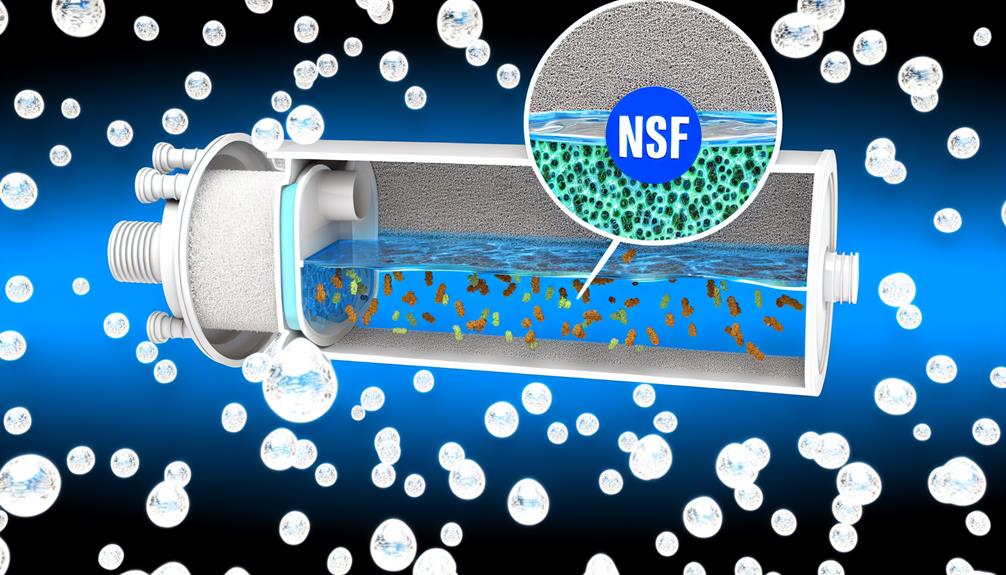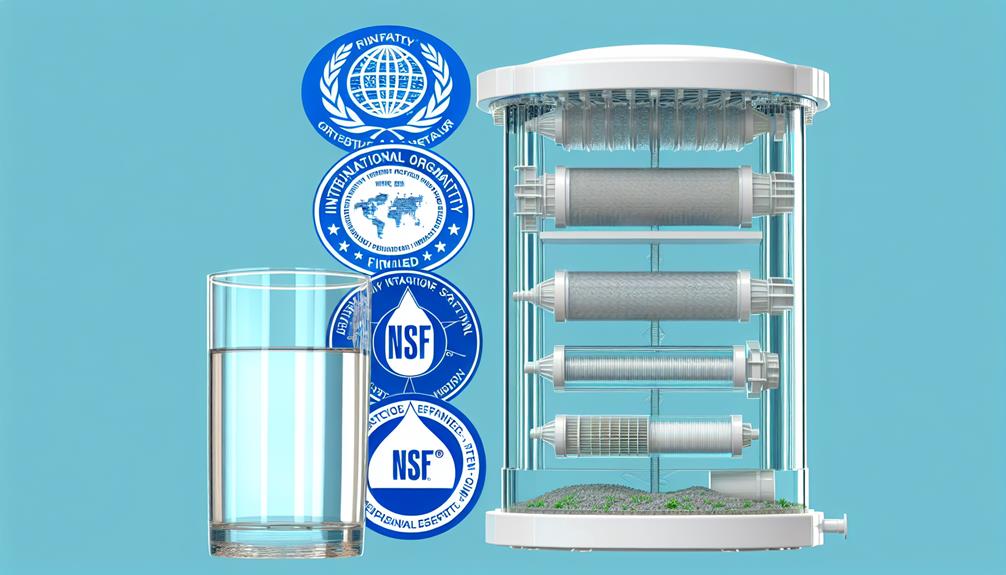Navigating the sea of regulations, you find that EU water filters must anchor themselves to stringent standards for a very vital reason: your health and safety are at stake. As you sift through the complexities of these regulations, you'll uncover that they serve as a bulwark against a plethora of contaminants that threaten to compromise the quality of the water you rely on daily.
These standards are not just bureaucratic hoops to jump through; they're the guardians of public health and environmental integrity, shaping the purity of the water flowing from your tap.
Yet, as you peer closer into the intricate mesh of rules and certifications, you'll begin to discern the broader implications these standards hold for the future of water safety in the EU—and possibly, you'll start to question whether your current water filter is truly up to the task.
EU Regulatory Framework
Within the EU Regulatory Framework, stringent guidelines and directives govern the standards for water filters to ensure public health and environmental protection. These standards are an integral part of the Drinking Water Directive, which mandates that EU Member States meet precise water quality objectives. You'll find that EU legislation, in this regard, isn't only meticulous but also harmonized across the European Union to maintain a uniform level of safety and quality.
The evidence suggests that the framework's effectiveness is more than just policy deep. Achievement rates soaring above 98.5% for clean drinking water between 2011-2013 demonstrate the framework's ability to uphold standards for drinking water. This success underscores the EU's commitment to aligning public health priorities with environmental safety. Moreover, the steady progress by newer Member States in meeting these objectives reflects the framework's flexibility and scalability.
The rise in bathing water sites meeting water quality standards—to an impressive 96.1% in 2015—exemplifies how the framework not only aims to protect health and environmental interests but achieves tangible results. By facilitating improvements in wastewater treatment and ensuring more of the population is connected to adequate facilities, the EU Regulatory Framework is a cornerstone in safeguarding Europe's water resources.
Health and Safety Mandates
As you consider the EU's Health and Safety Mandates, it's clear that the recent implementation of stricter lead reduction standards reflects a rigorous commitment to safeguarding public health through improved water filtration. The shift from a maximum allowable lead concentration of 10 parts per billion (ppb) to 5 ppb in filtered drinking water, as per NSF/ANSI 53 and NSF/ANSI 58, is a testament to the EU's proactive stance on contaminant reduction.
This stringent measure not only enhances water quality but also minimizes health risks associated with lead exposure.
Your safety is at the forefront of these initiatives. The EU's directives are designed to combat the challenges of water pollution, including agricultural runoff, storm water overflows, and novel pollutants like microplastics. The Environmental Protection Agency collaborates closely with NSF International, leveraging its expertise to inform standards development, ensuring that water filtration systems are rigorously tested and certified for effectiveness.
These health and safety mandates aren't mere formalities; they're essential barriers protecting human health from the adverse effects of contaminated water. By adhering to these elevated standards, the EU ensures that drinking water filtration systems deliver safe, high-quality water, free from harmful contaminants.
Water Quality Benchmarks
Evaluating the EU's water quality benchmarks reveals a significant uptick in compliance, with 96.1% of bathing water sites surpassing minimum standards and clean drinking water achievement rates exceeding 98.5%.
The Safe Drinking Water Act and other regulations have set stringent standards for the water treatment industry, ensuring the safety and quality of drinking water through rigorous drinking water filtration processes.
To give you a clearer picture of what these benchmarks entail, consider the following:
- Drinking Water Filtration: Filters must remove or reduce contaminants to low concentrations, safeguarding against health effects from impurities.
- Filter Elements: The standards include specific requirements for filter elements to consistently maintain the quality of drinking water.
- Health Effects: Rigorous testing is mandated to ensure that no adverse health effects arise from contaminants in the water.
- Standards Include: Parameters for microbiological, chemical, and physical properties of water, setting the bar high for drinking water filters.
The technical and analytical approach to drinking water filtration in the EU reflects an understanding that even trace contaminants can have significant health effects. Consequently, the water treatment industry must adhere to exacting requirements, ensuring that every filter element contributes to the overall safety and quality of drinking water.
Certification Processes
To ensure the highest standards of water safety, certification processes for water filters now include more stringent lead reduction requirements, reflecting the latest scientific findings on the health risks associated with lead exposure. The joint committee governing NSF/ANSI 53 and NSF/ANSI 58 has amended the criteria to lower the maximum allowable lead in filtered water from 10 parts per billion (ppb) to 5 ppb, in line with Health Canada's updated standards.
Certification bodies like NSF test and verify that Drinking Water Treatment Units, including those utilizing Activated Carbon and Reverse Osmosis technologies, meet these enhanced requirements. To reduce lead effectively, these systems mustn't only diminish the concentration of lead but also ensure the structural integrity and material safety of the components in contact with drinking water.
When you choose a water filter certified by NSF, you're selecting a product that has undergone rigorous testing. These standards provide a benchmark for performance, ensuring that the device you rely on for clean water functions at the highest level. The recent changes signify an advancement in public health protection, compelling manufacturers to adapt their products to meet the evolving scientific consensus on lead toxicity.
Compliance Benefits
Meeting the enhanced NSF/ANSI standards for lead reduction not only safeguards your drinking water but also signals a manufacturer's dedication to health and safety, fostering consumer confidence and market trust. When you comply with these standards, you're not just following a regulation; you're providing the best possible proof that your product is committed to the highest standards of public health.
Here are four pivotal benefits of compliance:
- Health Protection: By adhering to the lowered lead content threshold, from 10 ppb to 5 ppb, filtration products significantly reduce the risk of lead ingestion, thereby protecting human health.
- Consumer Assurance: Independent testing and certification against National Standards Institute (ANSI) benchmarks provide a clear, quantifiable assurance of water treatment effectiveness for consumers.
- Environmental Responsibility: Compliance demonstrates an environmental commitment, ensuring that water filtration systems don't contribute to contamination but rather enhance the quality of drinking water to protect ecosystems.
- Market Competitiveness: High-quality standards elevate a brand's market position, as adherence to stringent regulations is often a key differentiator in the competitive landscape of filtration products.
As you engage with water filtration systems, remember that compliance is an investment in quality, safety, and the environmental future.

